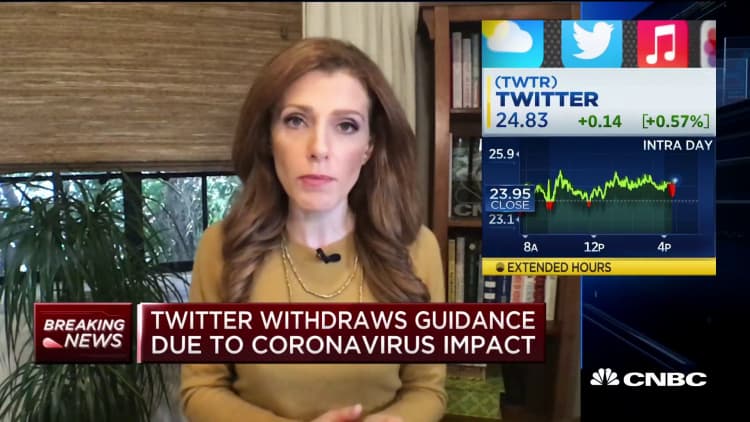As the crisis surrounding the COVID-19 coronavirus pandemic deepens and more U.S. states tell residents to stay home, consumers are increasingly flocking to Twitter for updates on the health, political and economic fallout.
Twitter tends to thrives in times of hardship and chaos because of the ways the site allows its millions of users to read and respond to the latest news. But the company's economic engine is advertising, which is often one of the first items that businesses cut during a financial downturn.
On Monday, Twitter withdrew its revenue and profit forecast for the first quarter as well as its outlook on costs for the full year, citing the potential impact of the spreading coronavirus on advertiser demand. While Twitter didn't say what types of companies are pulling back, the company is preparing the market for a potential steep drop-off, and investors will be paying close attention in the coming days and weeks for commentary from Google, Facebook, Snap and Pinterest.
Across California, New York and other states, restaurants and hotels have closed or drastically reduced their operations. Airlines are reportedly considering a voluntary shutdown, events and concerts have been canceled and retailers have shut their stores and moved all commerce online. Across the board, mass job losses are on the way, with Bank of America forecasting a total of 3 million weekly jobless claims when the number is released on Thursday.
The postponement of the Tokyo Summer Olympics will lead to a massive hit on ad spending. Comcast's NBCUniversal, which announced a partnership last summer with Twitter for the 2020 Olympics, said earlier this month it has sold more than $1.25 billion in national advertising for the games, a new record.
In the U.S. digital ad market, which eMarketer had expected to top $150 billion this year, the retail sector is the biggest spender. Travel was expected to surpass consumer packaged goods this year as the No. 4 market for digital ads, with entertainment coming in ninth.
'Sales and marketing is the easiest thing to turn off'
Twitter made it clear that the problem is advertisers, not usage — people are coming to the site and the app.
What Twitter calls monetizable daily active users, or the users that can be served ads, climbed 23% so far this quarter from a year earlier to 164 million. The average growth over the prior four quarters was 16%.
"Twitter's purpose is to serve the public conversation, and in these trying times our work has never been more critical," CEO Jack Dorsey said in Monday's statement. "We're seeing a meaningful increase in people using Twitter, and our teams are demonstrating incredible resilience adapting to this unprecedented environment."
But Twitter described the financial impact of the coronavirus as "rapidly evolving and difficult to measure." That's because it's not yet clear how dramatically advertisers are going to respond and how long the crisis will last.
"When a crisis occurs, sales and marketing is the easiest thing to turn off, especially in digital," said Sam Zietz, CEO of Grubbrr, which builds kiosks for restaurants as an alternative to counter-based ordering. "I can push a button. The knee-jerk reaction is to push that button, and everything goes to zero."

Wedbush analysts said in a note Tuesday morning said Twitter's decision to withdraw guidance reflects an environment where more impressions might not translate to revenue growth. China's Baidu and Weibo sites both warned investors of potential revenue shortfalls despite increased traffic, and the New York Times slashed its forecast in early March.
Jay Dunn, the chief marketing officer of strategic marketing firm Chief Outsiders, said that, based on conversations with his network of digital agencies and industry executives in retail and e-commerce, pay-per-click and social media spend has been largely turned off. What digital spend remains is highly targeted and focused on generating sales from "perceived high-intent audiences," Dunn said in an email.
"Live to fight another day and keep as many employees on board as possible," Dunn wrote. "Cut non-productive spend, especially marketing, and keep the lights on."
What this signals for digital spend
In a report to clients after Twitter's announcement, Michael Levine of Pivotal Research estimated that the company is "pacing down 35% to 40%" for March and is probably off by 10% or more from its guidance. In early February, Twitter said first-quarter sales would be between $825 million and $885 million.
While Facebook and Google will probably fare better than Twitter, Pivotal projects problems ahead for the whole group.
"Based on what we have been hearing in the channel, we would not be surprised if this likely sets a tone for what to expect in the June quarter for online advertising," wrote Levine, who has buy ratings on Twitter and Alphabet and a sell recommendation on Facebook. He added in a note on Tuesday that in the near term, TV ad revenue will be "relatively better insulated than online revenues."
Media Radar, an online ad analysis firm, said Monday that brands it views as "at-risk" due to the virus spent $2.6 billion on ads across all formats in the second quarter last year. The "at-risk" category includes movies, lodging, tourism and auto dealerships, and the largest spender a year ago was restaurants, primarily large chains, which shelled out $1.2 billion in the second quarter.
Media Radar said it hadn't seen a big shift in restaurant spending, but travel was down 30% from the first week in February to the first week in March.
The spending decline has happened quickly, a stark reflection of the suddenness of the crisis.
Aaron Goldman, chief marketing officer of data science and marketing technology company 4C Insights, said that for the first half of March, his company saw spending across platforms — Twitter, Facebook (and Instagram), Pinterest, Snap, Amazon and LinkedIn — increase 25% from the prior year, which was in-line with growth in January and February. Goldman said he expects that growth has since slowed.
Disclosure: NBCUniversal is the parent company of CNBC.
WATCH: Big tech may lose advertising revenue amid coronavirus crisis, analyst says




